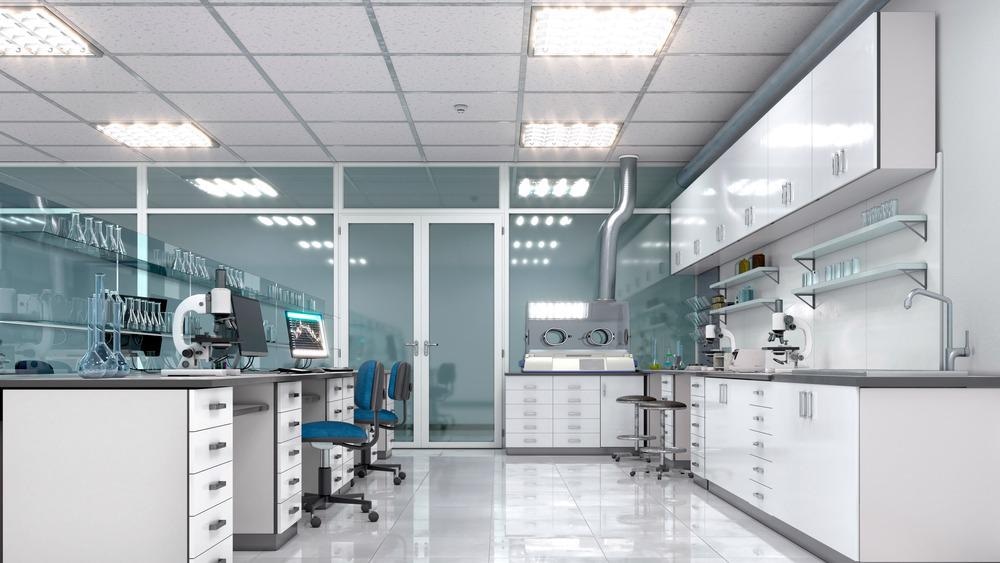Over the past several years, the integration of smart technology devices through the internet of things (IoT) within both the laboratory and medical settings has increased the efficiency of laboratory processes while also expanding the potential of these smart labs to conduct even more complex experiments.

Image Credit: urfin/Shutterstock.com
What is IoT?
By definition, IoT is a communication paradigm that involves the convergence of various high-functioning and connected components. Some of the different devices that can be integrated into this paradigm include, but are not limited to, robots, drones, security alarms, and office equipment. Ultimately, IoT systems reduce the need for human interventions by allowing devices to interact directly.
Energy Management
Within a standard laboratory setting, it is essential that all resources are efficiently managed to ensure that experiments can be conducted in a timely manner without any unwanted delays. Since most laboratories will house numerous energy-intensive equipment, monitoring these systems is essential, particularly when they are not consistently used.
Thus, connecting all of these systems, as well as lighting, projecting, and air conditioning systems within the lab, could reduce energy wastage while also reducing human efforts that would normally be needed to monitor these systems on a consistent basis.
In one recent study, researchers proposed an IoT framework that allowed for a smartphone platform to manage cloud-computing technologies. By allowing the IoT technology to remotely monitor and control high-energy appliances and systems within the lab, the researchers predicted that up to 30% of their energy consumption could be reduced each year.
Maintaining Sample Integrity
In addition to reducing unnecessary energy consumption, IoT also enables laboratory managers to remotely monitor equipment such as freezers and refrigerators within a laboratory. Since many laboratories will store irreplaceable samples in these freezers and refrigerators, which can be worth up to several millions of dollars in certain settings, managers need to be made aware of any temperature or humidity changes that could degrade these samples.
Similarly, sensors that are connected to a centralized IoT system can also provide information on carbon dioxide and oxygen levels within incubators to ensure that all cell and tissue cultures are maintained at optimal conditions. In the event that there is a leak or disconnect in gas lines to these incubators, laboratory professionals can be notified immediately to move their precious samples to a functioning unit.
In addition to monitoring these types of instruments, IoT systems can also be incorporated into laboratories to streamline data into electronic lab notebooks. This would allow high-level research scientists to be aware of a device’s usage and workload, thus providing them with information on how experiments are progressing within the lab.
Sample Tracking
Due to its low cost and reliability, barcode technology has been widely used throughout hospitals as a primary tracking method. The success of barcodes within the medical industry-led two-dimensional (2D) barcodes to subsequently be incorporated into the pharmaceutical drug discovery industry.
The use of 2D barcodes within these processes provides an added level of security to ensure the integrity of samples while also allowing managers to monitor samples as they progress through lengthy workflows.
Despite the utility of barcodes within the laboratory setting, various automated systems are not equipped with barcode scanners that could allow for samples to be tracked. As a result, laboratories that must track samples that are processed by these systems must integrate additional networked computers and barcode readers, which inevitably increases the cost of these processes while also eliminating otherwise useful bench space.
Recently, researchers have found that a central IoT device could overcome these issues.
This IoT system included a low-cost headless IoT computer, barcode reader, and multicolor light-emitting diode (LED) strip.
The IoT device reads container barcodes and sends data to central systems to be processed. If a barcode fails to be captured, a cable is disconnected, a network communication failure is detected, or any other issue arises, users are immediately notified through audio and visual feedback.
Important Considerations
Although there are several key advantages associated with integrating IoT into the laboratory setting, the installation of these systems and other associated hardware costs can be expensive. However, it should be noted that the loss of samples due to a freezer or incubator malfunctioning can be much more expensive than the costs associated with this form of sample protection.
In addition to added costs, there are certain security concerns that should be addressed before implementing IoT in a lab. For example, it is possible for hackers to break into these systems and damage hardware or samples by adjusting freezer and incubator settings. Additional privacy and security risks can be attributed to errors in the design or programming of devices.
To protect sensitive data from being compromised, it is recommended that research institutions encrypt all data, with each device using a different encryption key. Furthermore, the establishment of distinct laws that provide guidance on permissible and impermissible data practices and legislation that requires additional protections for sensitive data, such as biometric identifiers, can also provide an added layer of security for IoT labs.
References and Further Reading
Poongothai, M., Subramanian, P. M., Rajeswari, A., et al. (2018). Design and implementation of IoT based smart laboratory. IEEE Xplore. doi:10.1109/IEA.2018.8387090.
Gill II, J. M. (2018). The Internet of Things in the Life Sciences Laboratory. SLAS Technology 23(5); 405-406. doi:10.1177/247260318793101.
Neil, W., Zipp, G., Nemeth, G., et al. (2018). End-to-End Sample Tracking in the Laboratory Using a Custom Internet of Things Device. SLAS Technology 23(5); 412-422. doi:10.1177/2462630318783979.
Perkel, J. M. (2017). The Internet of Things comes to the lab. Nature 542; 125-126. doi:10.1038/542125a.
IoT (Internet of Things) Device Monitoring & Control in Labs Part 2 [Online]. Available from: https://econtrolsystems.com/blog/iot-internet-things-part-two.
Data privacy and the Internet of Things [Online]. Available from: https://en.unesco.org/inclusivepolicylab/analytics/data-privacy-and-internet-things
Disclaimer: The views expressed here are those of the author expressed in their private capacity and do not necessarily represent the views of AZoM.com Limited T/A AZoNetwork the owner and operator of this website. This disclaimer forms part of the Terms and conditions of use of this website.